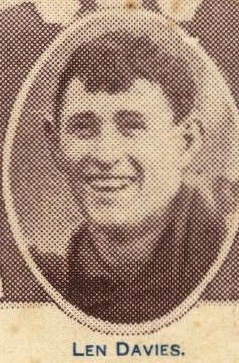For lovers of the beautiful game, a fascinating article by Russell Todd featuring some of Splott’s greatest footballers:
Rhodri Morgan, the late First Minister of Wales and sports nut, writes in his foreword to the Library of Wales compendium of sports writing:
“In all societies sports started as practice for hunting, and then as practice for war, or later as a substitute for war. In Wales, what is special is small country psychology – a special kind of need for heroes that could reassure us of our existence as a country. We might not have the conventional signs of life, or the institutional trappings of nationhood, but boy, could we produce runners and footballers and swimmers and Fighters we could all look up to.
Provided we had those heroes, we could do without our own royal family, our own parliament, national cathedral or supreme court. Our heroes reassured us that we were not going to disappear as a nation, that we could not be discarded into the dustbin of history.”
In working class communities this is even more so, because working class communities tend to have to establish and create their own institutions for cultural expression. It thus comes as no surprise that sport figures so prominently in the 50 Objects picked by the community: boxing, baseball, its rugby clubs, playing fields and of course footballers. Chiefly among these is Clive Sullivan, the Splott son of Caribbean immigrants who became a rugby league legend in the north of England.
In 1972, Sullivan became the first person of colour to captain any British or home nation national team when he led the Great Britain rugby league team onto the field against France in the World Cup, a competition whose trophy Sullivan would go on to lift three weeks later. In such esteem is Sullivan held in Hull – where he represented both the city’s principal rugby league clubs, Hull Kingston Rovers and Hull FC – that the A63 road between the Humber Bridge and the city centre was re-named in his honour: Clive Sullivan Way. It was not until 2023 that Sullivan was honoured in his home city with the unveiling of a statue of him and two other ‘Codebreakers’ – Billy Boston and Gus Risman – in Mermaid Quay.
In communities like Splott, rugby league was one of three ways of earning a living from one’s sporting prowess and athleticism. Boxing was another and, like rugby league, invariably saw its proponents having to leave Cardiff for fame and fortune. With a professional club in Cardiff and others in south Wales and just across the Channel, football offered talented young ‘Splotties’ an opportunity to earn a sporting living at home. This article is about Splott’s soccer stars.
Len Davies
Arguably the greatest footballer to come out of Splott, Len Davies makes it into the 50 Objects in his own right. Born 28th April 1899, Leonard Davies was one of a talented pair of footballing brothers at Radnor Road School but, because his family could only afford one pair of boots and because they were too small for his brother, Len was the beneficiary. Despite his small stature, Davies was lightning quick and as cool as a cucumber bought from a Splott Road grocer in front of goal. He was twice selected for Cardiff Schools and in 1913 represented Wales Schoolboys against their English counterparts at Merthyr Tydfil in front of a crowd of over 14,000.

Davies later signed for local teams such as Cardiff Teilo and Canton Vic but had caught the eye of Cardiff City’s selectors. Davies’s break came when Vic declined to select Davies for a friendly in 1917 against the Bluebirds considering him “too small for such an ordeal”. The professional team promptly picked him, Davies scored twice. As a qualified marine engineer Davies was not persuaded that football should be his career and went sea. But Cardiff City’s manager Fred Stewart eventually got his man, initially on amateur terms before turning pro in November 1919.
Davies remains the only Bluebird to score over 100 league goals and was a member of the famous 1927 FA Cup winning team, a particularly sweet moment for Davies who had missed out on playing in the 1925 final after taking a knock to his knee for Wales against Scotland a few weeks before. Davies loved representing his country and did so with distinction. He was first selected, alongside his Cardiff City teammate and ex-Radnor Road pupil, Herbie Evans (see below) for a Home International match against Scotland at Wrexham’s Racecourse ground and he scored within seven minutes to set up a 2-1 win. In 1924 he scored in the same fixture as Wales made a clean sweep of the other home nations to win only their third ever Home Championship, a feat repeated in 1928 with Davies ever present once again. Even in retirement he would reputedly send the Football Association of Wales a good luck telegram before matches and saying his boots were still oiled if he was wanted!

Herbie Evans
Herbert Evans was born in Llandaf in 1894 but raised in Splott where he attended Radnor Road School before later playing for Cardiff Corinthians. World War One interrupted his career but after winning a medal for gallantry he signed for Cardiff City in 1920, initially as an amateur, before joining Tranmere Rovers in 1926. He won a Wales amateur cap in 1922 before winning full honours in the same fixture as Len Davies against Scotland at Wrexham. Described as ‘sturdily’ built, in total Evans won six caps and probably would have won more had a broken leg brought a premature end to his career. Evan s also represented Glamorgan in first class cricket.
Frank Rankmore
Has anybody racked up as many airmiles to win a Wales cap as Frank Rankmore? Rankmore won his only Wales cap in a game against Chile in Santiago on Wales’s 1966 South America tour. By this time he was a Peterborough United player having joined ‘Posh’ from Cardiff City three years earlier. Rankmore had struggled to break into the Bluebirds’ first team and only did so when club legend Danny Molloy left in 1961 but that same season Cardiff were relegated to division two.
Rankmore later played for Northampton Town and when he hung up his boots moved into the pub trade. In 1975 he brought his family abc to Splott, settling in his parents’ former home at 29 Walker Road, and became a toolmaker. His final job was as a doorman at the St. David’s Hotel. Frank passed away in 2022 aged 83 having suffered with Alzheimer’s in his final days.
Ron Stitfall
Upon his death aged 82 in 2008 The Independent’s obituary was entitled Ron Stitfall: Stalwart of Cardiff City FC and how true that was. Ron was a one club man who stands eighth in the all-time Cardiff City appearance records with 402. Had the start of his career not coincided with the end of the war this tally would surely be higher. He spent 17 seasons as a player at Ninian Park but his association with his beloved Bluebirds started out on the terraces in the 1930s, a time when Ron was also selected as a Moorland Road pupil to represent Cardiff and Wales Schoolboys teams.
In 1964, Stitfall finished playing and began coaching Cardiff’s youth team, including a young John Toshack. His 30 year stint at Ninian Park came to an end when he became a trainer at Newport County and later coached the Wales youth team. His final role in football was as kit man for the national team from under 16s all the way up to the senior men’s team.. Stitfall gained two caps for Wales, debuting in a 5–2 defeat against England in November 1952 and winning another cap five years later against Czechoslovakia.
Albert and Bob Stitfall
Ron wasn’t the only talented footballing Stitfall brother. Albert played alongside Ron on a handful of occasions as a defender before moving to Torquay, while Bob Stitfall was a reserve goalkeeper at Cardiff.
Billy James
William ‘Billy’ James made waves in youth football as another Moorland pupil but World War Two struck just as he should have taken the game by storm. Raised on Carlisle Street, James joined Cardiff City just as war broke out. In 1940 he scored 8 goals in a game for Cardiff City against a strong Army XI and played in two wartime internationals in 1941 for Wales against England, scoring one goal, before enlisting with the 77th HAA Regiment, Royal Artillery, a unit that contained a number of footballers including other Cardiff City players Ernie Curtis and Billy Baker. After Japanese forces launched several attacks in the Far East Kong, Singapore and Malaya James and his unit were deployed to Java where he was taken prisoner by Japanese forces.
Three years of brutal treatment as a prisoner-of-war took their toll and he returned to Splott severely malnourished and damaged eyesight. Although he resumed playing for Cardiff City in the 1946–47 season, scoring in his first two matches in the Football League, James was forced into retirement at the end of the season. The club held a benefit game for James in May 1950 and he later scouted for the club while working as an office supplies salesman.
Ken Hollyman
Born in Adamsdown but a contemporary of Billy James, Ken Hollyman was unlucky to never win a full Wales cap but represented the Wales Servicemen team in a wartime match against a National Police XI in 1942. He played over 400 Football League games as a tough, stocky wing half for Cardiff City and Newport County, for whom he famously rifled in a 40 yard goal at White Hart Lane against Spurs in a 1959 FA Cup tie.
Whilst waiting for his demobilisation orders at the end of the war, Cardiff manager Cyril Spiers phoned Hollyman and asked him to play in a friendly match the following day against the touring Moscow Dynamo team at Ninian Park. One complication: Hollyman was in Oxford! So he hitchhiked to Ninian park whilst wearing his demob suit and trilby hat and made it back just in time to face the Russians who cantered to a 10-1 victory, at the time by far the heaviest loss any British side had ever suffered at the hands of foreign opposition.
Hollyman represented the Wales baseball team four times, including as captain, having grown up playing the summer sport at Moorland Park and elsewhere in the city.
Nicky Fish
Born into a Splott footballing family, Nicky looked to have an encouraging professional career ahead of him. He had won two under 21 caps for Wales and was on the fringes of the Cardiff City first team and had recently made his debut in a League Cup game. Fish was part of a promising crop of young players at City with the likes of Joe Ledley and Stuart Fleetwood. Tragedy struck when Fish and Fleetwood were involved in a car accident on the way home from a game at Hereford. Fish was in intensive care for weeks and though he eventually recovered to full health his injuries deprived him of the chance of pursuing his professional dream. Fish later turned out for Bridgend Street and worked at the STAR Centre and is still seen around Splott.
Ibrahim Farah
Born in Butetown, Farah’s family moved to the Splott shortly after he was born where he attended Moorland Primary School. Farah joined Cardiff City’s academy at the age of 14 and eventually signed a professional contract. He made his professional debut against Oxford United on 10 August, in the League Cup. Later played for Carmarthen Town.
Eddie Jenkins
Edwin Jenkins worked as a milkman while playing local amateur football for Splott Labour Amateurs and when he was invited to a trial at Cardiff City and being offered a contract in 1930 and soon making his professional debut on 4 February 1930 in a 2–1 defeat to Bradford City in the Second Division. He made a handful of further appearances deputising for club legend Fred Keenor who was entering his final few weeks with the Bluebirds. Jenkins made 87 appearances for Cardiff and was offered a contract at Spurs but decided against it because he felt that “there were better prospects in the milk business”. How times have changed!
Jenkins later played for Bristol City and Newport County before serving in the navy in WWII during which he was awarded the Africa Star. He remained in the milk trade, became a Freemason and qualified as a referee. In 1983 he wrote a book about his home district entitled The Splott I Remember. When Jenkins died in August 2005 aged 96 he was the oldest surviving former Cardiff City player.
Craig Bellamy
It is fitting that Craig Bellamy’s first official engagement as Wales manager was at an evening with fans at Splott Cons Club as Splott is where he spent his early years before his family moved to Trowbridge.
Bellamy is a bona fide Welsh football legend: in the all-time top ten lists for appearances (72, 16 as captain) and goals (19), scorer of the famous winner against Italy in 2002, and mentor in the aftermath of the tragic death of his friend Gary Speed to many of the squad who went on to light up Euro 2016.
Although Bellamy refers to Trowbridge as ‘home’ in his autobiography Goodfellas, he recalls Splott fondly and with a keen sense of its heritage:
“As a small kid, we lived in Swinton Street. The railway tracks were at one end of our road and trains trundled past there, heading out of Cardiff Central east towards England and London. At the other end was Splott Park and behind that was the giant spread of Allied Steel and Wire where my old man worked. They closed it down in 2002. It was sold on to a Spanish company. Its great blue bulk still dominates that part of the area, but most of the jobs went.
There was a time in Splott when you could see the flames and the sparks dancing in the night air from the famous old Dowlais ironworks and women worried about putting their washing out on the line because it would get covered in a film of fine red dust. Cardiff used to be an ironworks and steel town but the industry was dying when I was a kid. In 1978, the year before I was born, thousands of jobs were lost when the East Moors Steelworks closed down.
But there was a great sense of community. Originally, people had been transported there from the Valleys to work in the factories and it was still a traditional working class area where it felt like every door was open. If my mum ever shut herself out by mistake, she’d knock next door and the neighbour would send her kid round through our back garden, through our back door and he’d open up for us at the front.
I always felt like we had a decent living from what my mum and dad did. We were happy enough. My mum was a cleaner and my world was all about playing in the warren of streets round our house, Baden Powell School, Splott Park and Splott Baths. My dad, Douglas, worked at Allied Steel and Wire for as long as I can remember even though we moved away from Splott, a few miles further east to Trowbridge, when I was five.”
Unbeaten in his first eight games as Wales manager, Bellamy has made a promising start in what could become an international managerial career as successful as his international playing career was.
Colin Baker and Nick Deacy
Can Splott claim another pair of Wales internationals? Though Colin Baker and Nick Deacy are Tremorfa boys they played a lot of junior football in Splott so let’s claim them.
Baker was a wing half at Cardiff City when in 1958 and after only a single under 23 appearance for Wales he was surprisingly included in Wales’s squad to compete in the World Cup in Sweden. He probably would not have been selected had it not been for an injury to his Cardiff teammate Alan Harrington. Baker’s luck didn’t run out in the tournament itself when Derrick Sullivan was injured in the opening game allowing Baker to make his international debut in the second game against Mexico. It was his only appearance in the tournament and he went on to win a further six caps until 1961 before falling out of favour with manager Jimmy Murphy. Baker holds the distinction of being the first Cardiff player ever to be substituted in a game.
Deacy was combining a Guest Keen steel apprenticeship with ripping it up in amateur football in Cardiff with the Corinthians when there was a knock at his parents’ door one night as Nick and his family were settling down to watch television. Standing at the door was John Charles! A hero of Deacy’s father, he was speechless when he invited the ‘Gentle Giant’ into the living room. Charles was manager of Merthyr Tydfil and wanted to sign the promising young striker.
From Penydarren Park Deacy embarked on a remarkably nomadic career that took him to Hereford, Workington in Cumbria, PSV Eindhoven – where he won the Uefa Cup in 1978 – Belgium, Hong Kong, Hull, back to Merthyr and more. He had a short Wales career with his twelve caps coming in the space of 18 months between 1977-78. He scored on his debut in a World Cup qualifier against Czechoslovakia at Wrexham and scored four international goals in total.
Giorgio Chinaglia
Finally, if we can lay claim to a couple of Tremorfa boys we can also lay claim to a bambino from over the other side of Newport Road, not least because his dad worked at the steelworks. For a brief period in the mid to late 1970s football was big business in the United States. Its league, the NASL, was attracting talent from South American and Europe, principally Pele who was persuaded out of retirement to sign for New York Cosmos,becoming the world’s highest paid sportsperson on the planet. Incidentally, it was former West Ham, Aston Villa and Wales footballer Phil Woosnam who was central to the deal, in his role as NASL Commissioner.
One of the other stars of that era was born in Italy but moved to Cardiff at the age of 9. Chinaglia senior found work at the steelworks and initially the family of four lived out of a single room.
“It was tough. I used to take the milk left on people’s porches and drink it for breakfast. I didn’t look at it as stealing, exactly. I just borrowed it.”
According to some sources, this room was in a house in Splott. Other sources state that the Chinaglias lived in Talworth Street off City Road in Plasnewydd.
When he was 13 Chinaglia was playing in the Cardiff youth league and was spotted by Trevor Morris, the coach of Swansea Town. Morris had come to look at a lad that had been recommended to him, but it was Chinaglia who caught his eye. By this time, Girogio’s father had scraped together enough money to open a restaurant on Newport Road in Rumney and the contract at Swansea took Giorgio away from the restaurant’s kitchen and waiting on tables.
At 19 and already making waves with the Swans – including reputedly attacking Morris with an axe! – the Chinaglias returned to Italy and Giorgio had to undertake his compulsory military service. He completed it in a regiment specially for footballers so he could continue to train and represent his club on match days. At 22 Giorgio found his way to Lazio where his career really took off including winning international honours with the Azzurri for whom he scored in each of his first three matches and also played at the 1974 World Cup. When he had finished playing in New York as the NASL’s all-time record goalscorer Giorgio had earned enough money to own a 22 room mansion in New Jersey…a long way from living in a single room in Splott and Talworth Street!



